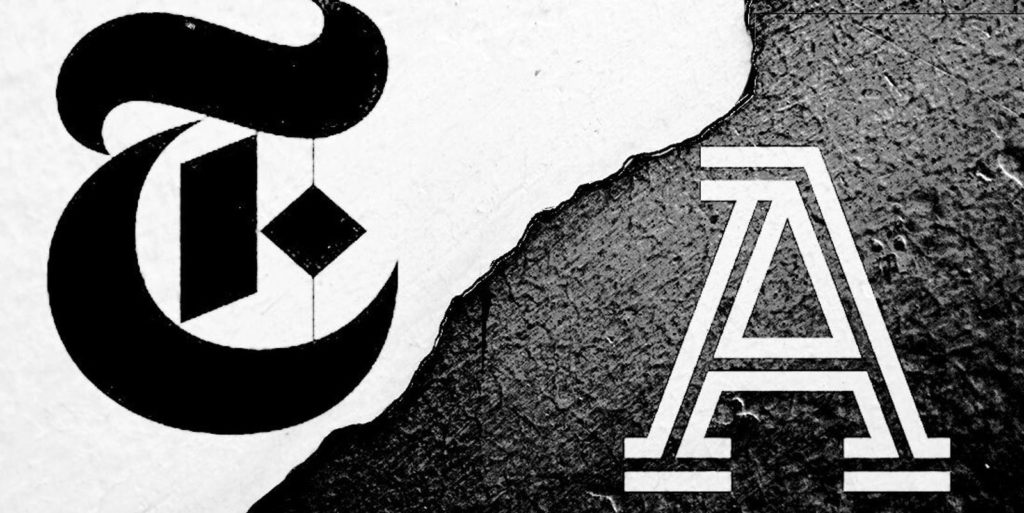The New York Times has agreed to buy San Francisco-based, sports news brand The Athletic. The world’s most successful daily newspaper (with more than 1m subscriptions outside the US) is paying $550m for a loss-making business with forecast revenues of $77m in 2021. But the consideration is substantially lower than The Athletic’s recent asking price of $800m, before the vendors got real.
It was founded in 2016 and covers both professional and college level sports. In a 2020 fundraise two year, it was valued at $500m. But the pandemic has hurt the company with the cancellation of live sports during intermittent lockdowns; it has cut headcount by almost 10%.
The reality of the deal was spelled by Dylan Byers, founding partner of Puck News who reported: “Six years ago, (Alex) Mather and (Adam) Hansmann had capitalized on the disruption of the newspaper industry by snapping up many of the nation’s best local sports reporters and fashioning themselves as, in Mather’s words, “the local sports page for every city in the country.” Nevertheless, they were still burning about $50m a year on average and appeared to be hitting a growth ceiling. And yet, they’d managed to convince the subscriber-hungry Times that their 1.2m paying readers were worth more than half a billion dollars. It was probably the most lucrative and well-timed exit they could have hoped for.”
The acquisition will add those 1.2m subscribers (many of them believed to be on discounted rates) to the New York Times and supports its strategy of reaching 10m subscribers by the end of 2025. The 170-year-old daily’s subscription-first business plan has helped it grow, despite steep declines in advertising and print sales. But it has some changes to make.
The Athletic burned through $95m during 2019 and 2020, reflecting the cost of building a 600-person reporting staff to cover local sports in both the US and Britain, according to The Information. During those two years, it had revenue of $73m: “It shows the challenge for digital media firms of building profitable businesses while investing heavily in content to draw subscribers.”
The Information has provided the following financials and projections:
| 2019 | 2020 | 2021* | 2022* | 2023* | |
| Revenue | $26m | $47m | $77m | $119m | $156m |
| Net cashflow | ($54m) | ($41m) | ($35m) | ($7m) | $15m |
The Athletic has now been operating for almost six years and had no prospect of ending the losses before 2023 – and even that debut profit would have depended on more than doubling revenue in the next two years.
Flashes & Flames has consistently advocated the potential of stylish newsletters like The Athletic to “steal” content verticals from daily newspaper brands. That’s been the motivation for Axel Springer – one of the world’s best legacy media reinventions – to acquire Business Insider, Morning Brew and, now, Politico in the US.
Email newsletters can have obvious appeal especially to millennials who will pay for content that specifically meets their needs (rather than as part of a newspaper-like bundle for everyone). But these targeted newsletters should also have production and distribution cost-advantages over traditional news brands.
The trouble is that the business model of startups can be distorted by the willingness of investors to provide more cash than they actually need. Has The Athletic been another example (like Vice, perhaps) of digital media whose costs (ie staffing) are a result of “excess funding”? And does this now make it vulnerable to counter-innovation from traditional operators or truly low-cost startups?

In the UK, The Athletic has been competing with national daily newspapers for hugely popular Premier League football-soccer content. You might think it would be a good time for these legacy brands to fight back with subscription newsletters of their own. The incumbents really could become low-cost rivals.
It’s been difficult to get reliable subscription numbers for the Athletic. But the 2020 revenue figures (above) imply something less than the 1.2m paying subscribers once claimed after apparent “growth” to 1m a year ago – a year after that was first forecast. Whether or not, these totals have been reached – let alone sustained – the 50% “launch discount” is still being offered in both the UK and US, six years after launch. That was worrying.
The widespread increase in paid subscriptions and a growing realisation that good journalism is worth paying for is one of the most promising signs for digital media. SubStack is helping to strengthen the trend. But The Athletic’s persistent price-cutting, presumably, reflected some difficulty in actually retaining subscribers.
Reducing churn is all about getting the content right and keeping readers hooked. In an era of unlimited choice and endless distraction, digital media must fight to keep its place (literally) in readers’ lives. But, far from helping to build reader engagement, continually offering 50% discounts might actually increase the churn by undermining the publication’s prestige among existing subscribers.
It’s another part of The Athletic story that hasn’t really added up. Like the supposed problems of pandemic years 2020 and 2021, during which its revenue actually increased by 81% and 64% respectively. Or the fact that it has recently been chasing advertising revenue as well as subscriptions – and was expecting to increase ads from $3m in 2020 to $31m in 2020. It seemed like an odd response to the challenge of subscriber churn.
That’s because the real story of The Athletic is its cost base.
The five years of financials show that annual spending would have increased from $80m in 2019 to $141m in 2023:
| 2019 | 2020 | 2021 | 2022 | 2023 | |
| Total cash cost | $80m | $88m | $112m | $126m | $141m |
| Annual change | +10% | +27% | +13% | +12% |
A full one-third of the $42m (55%) additional revenue forecast for 2022 would have been swallowed up by increased costs. That’s not how it’s meant to be for digital newsletters which have none of the production and distribution costs of traditional media. And this is a business supposedly in a life-threatening fight to stop the losses.
But, if only the $112m total cash costs in 2021 were pegged for three years – instead of increasing by double-digits each year – The Athletic could actually become profitable in 2022. On that basis, it might make a margin of some $44m (28%) in 2023. That has persuaded the New York Times profitability is in sight – if the revenue growth can be achieved. But – final thought – the acquisition also gives the New York Times an even greater footprint in the UK (home of Premier League soccer-football). It may, therefore, increase the likelihood of a NYT bid for, say, the UK’s family-owned, sports-strong Daily Telegraph. New York’s finest is more global than ever.
**Some of this report has been published in an earlier edition of Flashes & Flames



